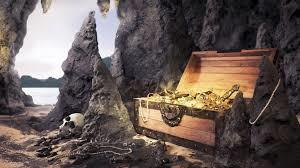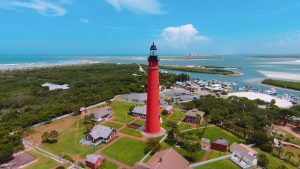Marilyn Turk's Blog, page 7
December 8, 2018
Christmas Delivery at the Lighthouse

A Present for the Sentinel by Charles Wysocki
How did the lighthouse keepers get their Christmas packages delivered?
Most were sent by ship because there were often no roads to the lighthouses, or if there were, they might be impassable during part of the year. Our lighthouse keeper in this picture by Charles Wysocki could be reached by land. Do you think the deliverer is UPS, Fed Exz or what?
Are you having any packages delivered this Christmas or are you delivering them in person? I pray you’ll be as blessed to be the giver as the recipient. And if you don’t receive any gifts, remember, you’ve already received the greatest gift of all.
“For God so loved the world that he gave his one and only Son, that whoever believes in him shall not perish but have eternal life: John 3:16 (NIV).
Have you opened your gift yet? This is one gift you don’t have to wait until December 25 to open.
November 25, 2018
November 22, 2018
Thankful for Fall at Esopus Lighthouse
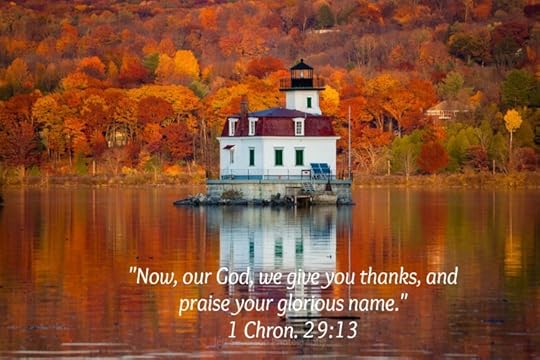
Esopus Lighthouse, NY, by Jeff Severson
I’m thankful for the fabulous colors of fall. What an amazing artist our Creator is!
Have a blessed thanksgiving!
Thank you to Jeff Severson who allowed me to use his gorgeous fall picture of Esopus Lighthouse, New York. You can find more of his beautiful photography at https://www.facebook.com/jeffseverson....
November 21, 2018
Happy Thanksgiving to all my lighthouse friends!
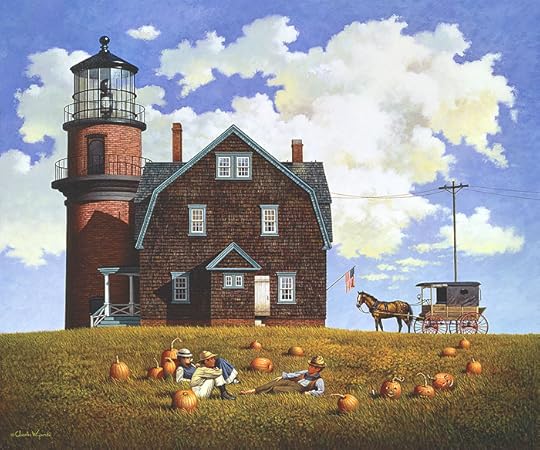
Gay Head Light by Charles Wysocki
“Give thanks to the Lord, for He is good; His love endures forever.” Psalm 107:1
November 10, 2018
Lighthouses Commemorate the 100th Anniversary of the end of WWI
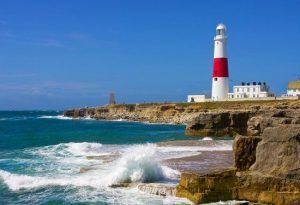
Portland Bill Lighthouse
Sunday, November 11, 2018, marks the 100th anniversary of the end of the first world war. To commemorate the occasion, an event called “Battle’s Over” has been planned. The event was inspired by a comment made on August 3, 1914, by Foreign Minister Sir Edward Grey who said as he looked out his office window at dusk as gas lights were being lit in London, “The lamps are going out all over Europe; we shall not see them lit again in our lifetime.”
Trinity House, the official General Lighthouse Authority for England, Wales, the Channel Islands and Gibraltar, will participate in WWI Beacons of Light. Similar celebrations will take place in New Zealand, Ireland, Australia, Bermuda, France, Belgium, Canada, the United States and Germany.
At 1900 hours, over 1000 gas-powered Beacons of Light will be lit, representing an end to the darkness of war. The following Trinity House lighthouses will be lit:
Heugh Hill Lighthouse (Holy Island, Northumberland)
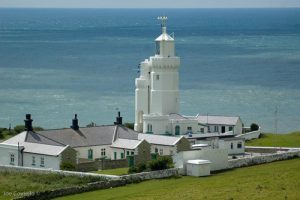
St. Catherine’s Lighthouse
Flamborough Head Lighthouse (Yorkshire)
Harwich Pier (Essex)
North Foreland Lighthouse (Kent)
St Catherine’s Lighthouse (Isle of Wight)
Portland Bill Lighthouse (Dorset)
Lizard Lighthouse (Cornwall)
St Annes Head Lighthouse (Pembrokeshire)
Start Point Lighthouse (Devon)
Cromer Lighthouse (Norfolk)
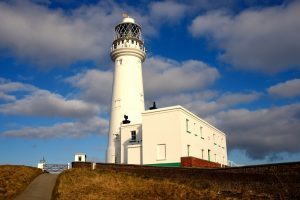
Flamborough Head Lighthouse by Ian Cowe
Thank you, Trinity House, for keeping the lights shining!
“Let your light shine before others, that they may see your good deeds and glorify your Father in heaven.” Matthew 5:16 (NIV)
August 24, 2018
Special Mission for a Lighthouse Tender
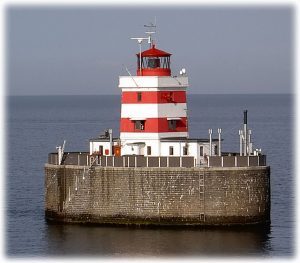
Drogden Lighthouse, Denmark
For years, this blog has featured only lighthouses and people who serve them, but today’s blog will be a bit different. Today, I want to tell you about a lighthouse tender, a very special lighthouse tender.
A lighthouse tender is a boat that brought supplies to lighthouses. For many of those who served at lighthouses, the tender was their main connection to the rest of civilization, greatly anticipated and vastly appreciated. The tender not only brought food and supplies for the lighthouse and the people stationed there, it also brought magazines, books, newspapers, and mail that linked them to the outside world. Many of these lighthouses were not land-based and the only people who ever visited were those who worked on the tenders.
In 1943, the Germans occupied Denmark. Ferdinand Duckwitz, a German businessman in charge of naval matters in the country heard about the Nazi’s plan to round up the entire Danish Jewish population and deport them to concentrations camps outside of the country. When he told the Danish public, many citizens of Denmark decided to oppose the plan and do what they could to stop it from happening. Even though helping “fugitives” endangered them, resistance groups up to help the Jews escape.
The Gerda III was a small oak and pine work boat that was built by the Danish Lighthouse and Buoy Service to carry supplies and men to and from the Drogden Lighthouse. Based in the fishing village of Gilleleje, the Danish shore was only eleven miles from Sweden, a neutral country.
To rescue the Jews, a flotilla of fishing and cargo vessels assembled to smuggle the refugees to safety across the Oresund Strait. The nineteen-year-old daughter of the Gerda III’s manager, Henny Sinding, orchestrated the use of the boat to participate in the rescue.
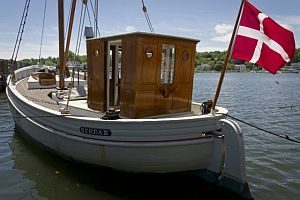
Gerda III
In October 1943, Henny and the four-man crew rescued over 300 people. Henny’s job was to find the Jews and get them to the Gerda III. In her own words, “My task was every evening to look for Jews (that had been hidden by friends and neighbors), to assemble them in groups of twenty or twenty-five, and to guide them to the warehouse, where we hid them. From there they had to cross the quay in the dark to get on the boat…
The Jews we brought passed the night in the warehouse granary, watching for favorable moments to cross the quay. In the warehouse we left them something to eat and drink, and also sleeping draughts to make the children sleep, as it was essential that no noise could be heard by the German soldiers patrolling outside. The boat couldn’t lift anchor until seven o’clock in the morning. When it started its engine, the two Germans on duty came on board to check the papers. They never thought to go down to the hold where they would have found our Jewish guests. Every morning, the crew offered a beer to the two soldiers; they toasted each other and talked about the weather. Then the Germans went back on the quay.”
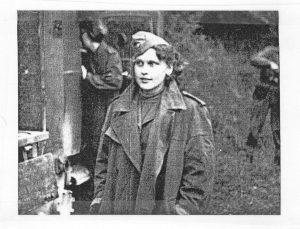
Henny Sinding
About one-fifth of the Danish Jewish population was saved as a result of Denmark’s brave citizens including a young woman named Henny.
In 1989, the Government of Denmark donated the Gerda III to the Museum of Jewish Heritage in New York City as a gift. She is currently cared for and exhibited at Mystic Seaport Museum.
“For the entire law is fulfilled in keeping this one command: ‘Love your neighbor as yourself.’” Galatians 5:14
August 7, 2018
Discovering a Book
People often ask me where I get the ideas for my books. Their question implies I’m creative and that I come up with these ideas all by myself.
Not true. You see, I’m a historical writer, so I like to explore history and find interesting facts about different periods in various places. Not that I bury my head in research books, but sometimes I stumble upon a fascinating tidbit or see an old building that piques my interest.
Then I wonder what it was like to live at that time in that place when certain things happened. That’s when the people (characters) show up in my mind and tell me about it. A story idea takes root in my little brain as I dig into the history and let the characters show me around. I follow them and see what they do, and the details come out when I begin to write the story.
 It may sound cliché, but as a Christian, I firmly believe God leads me to each story and reveals to me the lesson the characters will learn once they survive the conflicts, both external and internal. Many times, this belief has been affirmed when I find a detail that I need to make the story work, one I didn’t know existed until I began to write the story. No doubt God put that detail there for me to find.
It may sound cliché, but as a Christian, I firmly believe God leads me to each story and reveals to me the lesson the characters will learn once they survive the conflicts, both external and internal. Many times, this belief has been affirmed when I find a detail that I need to make the story work, one I didn’t know existed until I began to write the story. No doubt God put that detail there for me to find.
So, I’m not creative. Actually, I’m more of a literary archaeologist. I dig around in history and discover stories, then I write them. And because I’m not creative, just curious and committed to what God has given me, I have to give Him the credit.
What about you? Have you ever wondered what it was like to live in a different era? Have you ever seen an old mansion and wanted to know who lived there?

Indiana Jones, courtesy Paramount Pictures
June 19, 2018
New Name, New Lighthouse
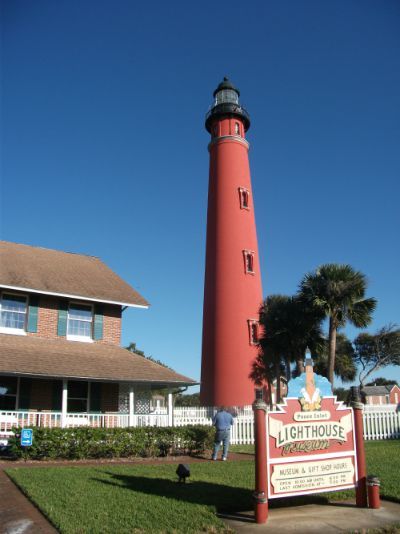
Ponce de Leon Inlet Lighthouse. Photo by Chuck Turk
Raise your hand if you want to go to Mosquito Inlet!
If you’ve had any experience with those pesky insects, you might think twice.
Mosquito Inlet was the exit point for two rivers in Florida – the Halifax River and the Hillsborough River. In the early 1800’s, the inlet was important to cotton, rice and orange plantations to transport their goods to the Atlantic Ocean and distant ports. In 1830, a petition to Congress was signed by plantation and ship owners from Mosquito County requesting a lighthouse for the inlet due to the difficulty in finding the inlet without one.
In 1834, Congress approved the funds for the lighthouse and the first one at the location was lit in 1835. However, the lighthouse was underpinned by storms and ravaged by attacks by the local Native Americans, making repair work impossible to that the tower and keeper dwellings washed into the sea.
Despite efforts to have the tower reconstructed, it wasn’t until after the Civil War that one was approved, and not begun until 1884. By then, the river traffic had dwindled, but the tower was approved to provide a coastal light midway between St. Augustine and Cape Canaveral.
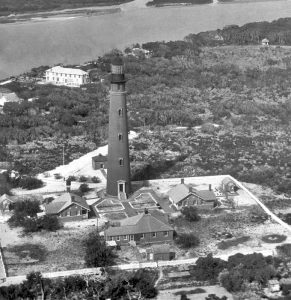
Pnce de Leon Inlet Lighthouse station, 1930, photo from U.S.C.G.
Over a million bricks were used to construct the new Mosquito Inlet’s 175-foot lighthouse, the only brick lighthouse taller is Cape Hatteras and the tallest lighthouse in Florida. Separate dwellings were built for the head keeper and two assistants, with the four structures laid out with brick walkways connecting to form the shape of a cross. A brick woodshed with a privy was built behind each dwelling, and a storage building was constructed for the station’s oil. The lighthouse was first lit in 1887.
In 1896, lightning struck the lighthouse, destroying the electric call apparatus used for summoning the relief keeper. Two years later, the gallery outside the lantern room was rigged with a spar and halyards, and the keepers were supplied with signal books, a set of international code flags, and a pair of marine glasses so they could communicate with offshore vessels.
Although Mosquito Inlet was the accurate name for the location, the name also kept people from settling in the area. So in order to attract more residents, the name was officially changed in 1926 to Ponce de Leon Inlet. Named for the famous explorer to Florida, the lighthouse also received a new name as the Ponce de Leon Inlet Lighthouse.
It’s interesting to note that Ponce de Leon is associated with the mythical “Fountain of Youth,” which would magically give eternal youth, essentially, new life, to those who drank its water. Although the story and the fountain have never been historically proven, people like to believe something exists that would make their lives forever better.
Today, the Ponce de Leon Inlet Lighthouse station is one of the best-preserved lighthouses in the country, thanks to the community that has grown up around it and given it new life.
But there is no Fountain of Youth. Or is there? In the Bible it says, “Therefore, if anyone is in Christ, the new creation has come: The old has gone, the new is here!” 2 Corinthians 5:17
I’ll choose that new life over mosquitoes any time.
January 16, 2018
Where did lighthouse keepers go in the winter?
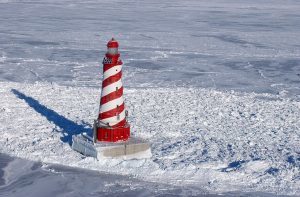
White Shoal Lighthouse, Lake Michigan , Not a good place to stay in winter
Did you think lighthouse keepers stayed and worked at the lighthouses all year long?
So did I, until I found out that this was not the case for lighthouse keepers on the Great Lakes. Unlike other bodies of water around the world, the Great Lakes become so covered with ice that maritime transportation is discontinued for the winter months.
From around November until March, shipping on the Great Lakes is at a standstill until the water warms up. Like animals going back to the barn, ships return to their shipyards in the fall and stay for the duration of the winter. And with no shipping, there’s no need for navigational aids like lighthouses, so the lights stayed dark during that time. Consequently, most Great Lakes lighthouse keepers on island lights and offshore lights left their stations.
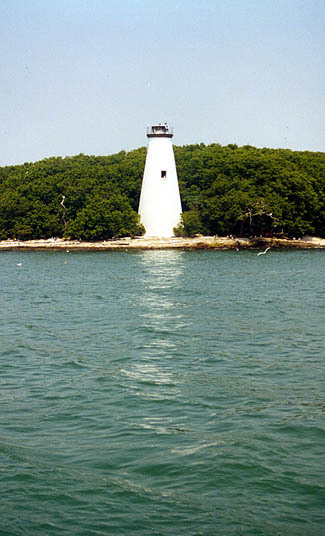
West Sister Island Light, Lake Erie, Ohio
One notable exception was Chauncy Fitzmorris who insisted on staying at the West Sister Island in Lake Erie to take care of his farm animals. His wife went to their home on the mainland, while Chauncey spent the winter alone on the island. He almost died one year when a bull gored him. Two weeks later, someone at the closest point on the mainland noticed the red distress signal and sent a rescue party just in time to get the keeper to a hospital. As a rule, Chauncey’s first trip to the mainland when the ice started to melt was recorded every year by the Port Clinton, Ohio, newspaper as a sign of spring!
But where did the other lightkeepers go? According to Great Lakes lighthouse historian Terry Pepper, the general understanding was that most of the keepers had family homes elsewhere where they could spend the winter. Some keepers found winter employment while others simply did maintenance on their homes and others found work as loggers, carpenters or handymen.
Some keepers did stay at their lighthouses on the mainland, although the lighthouses were quite remote. For example, the keepers at Au Sable Point Lighthouse on Lake Superior stayed throughout the year, but were quite isolated with no road to the light station until 1928. The nearest civilization was Grand Marais, which could only be reached by a 12-mile snowshoe or dogsled hike when no boats were on the lake. No doubt a trip to the grocery store would be out of the question, so it was necessary for the keepers to store up food and live off the land – fishing or hunting – to survive the brutal winters.
How are you handling this winter? Are you looking forward to warmer weather like I am, or have you gone farther south to avoid the cold? Or maybe you enjoy the winter months. One thing for certain, winter will be here every year.
“As long as the earth endures, seedtime and harvest, cold and heat, summer and winter, day and night will never cease.” Gen. 8:22
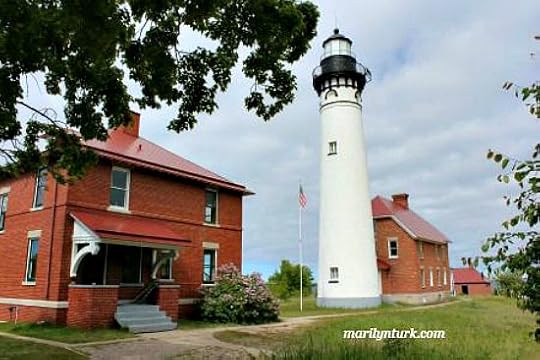
Au Sable Lighthouse, MI, photo by Chuck Turk
December 24, 2017
Christmas at Les Casquets Lighthouse

Les Casquets Lighthouse, photo by Juan Gutierrez Andres, courtesy of Wikipedia Commons.
One of the blessings of writing about lighthouses is meeting other people who love lighthouses, especially those who work with them. Since there are few lighthouses that still employ keepers, it is quite a pleasure to meet a keeper. I have been so thrilled to get to know Gordon Partridge, a former lighthouse keeper in the U.K. Last Christmas, he shared one of his stories with me (and you) about serving at the Needles Lighthouse during Christmas. This Christmas, he shares another Christmas story from the time he served at Les Casquets Lighthouse in the Channel Islands. Below is his story in his own words, since I love the way he tells a story. I hope you’ll be as blessed by it as I am.
A memory of Christmas meaning.
Christmas Eve 1988 on Les Casquets Lighthouse
I was duty watch at midnight on Christmas Eve. My thoughts were of my family at home and how much I missed being with them, especially in the morning when excited children would be waking to their Santa Claus deliveries!
It was a cold, starlight night, and the sea was amazingly calm. Some miles away, I could clearly see the lights of shipping as they made their way “up channel” towards the Strait of Dover and I wondered, and empathised as they too, were away from home, just like me.
The marine radio was eerily quiet save for the occasional static crackle, when, in a moment of impulse, I keyed the Mike and called out, “A Very Merry and Peaceful Christmas and God speed, to all out there, from Casquets Lighthouse!” What followed,found me frozen with human emotion, as for some 10/15 minutes, the airway was alive with festive greetings, some in English, but most in languages totally unknown to me, yet the warmth within their voices told me that they were well meant greetings reciprocating my original call.
So many of us, each away from where our hearts really wanted to be, sending love and fraternal feelings to their brothers and sisters at sea on Christmas Night.
After I had collected my thoughts, I once more stared out at the myriad of lights on the water and uttered a quiet “thank you” to my unknown friends.
Truly, a Christmas night that will live with me forever.
May God fill your heart with hope and love this Christmas!
“And the angel said unto them, Fear not: for, behold, I bring you good tidings of great joy, which shall be to all people.” Luke 2:10 KJV

